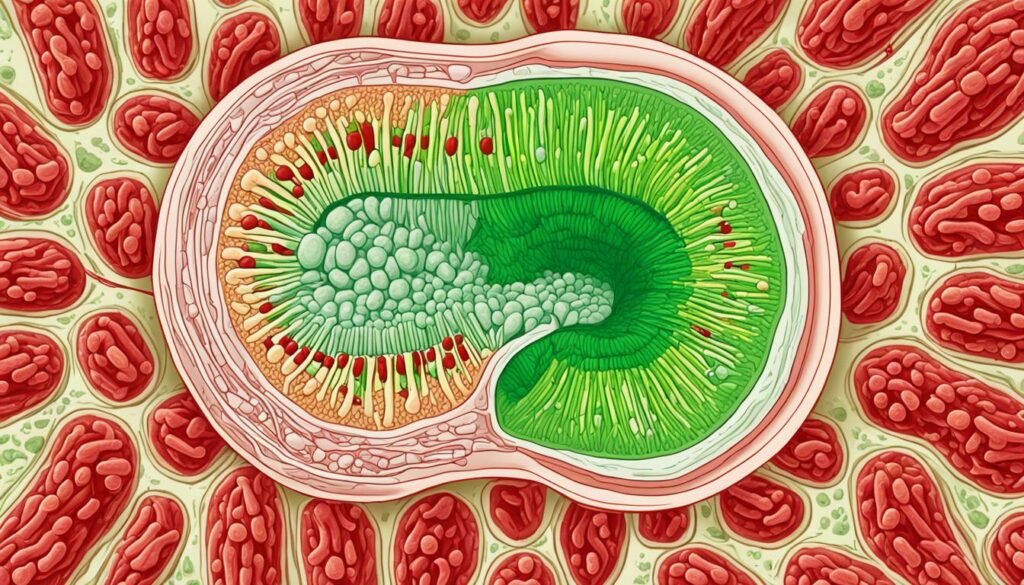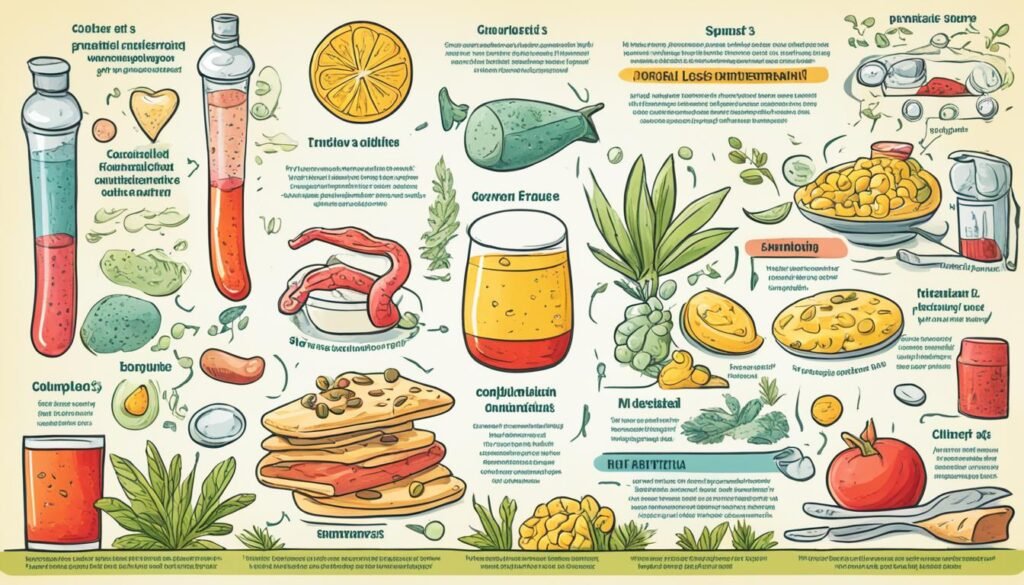Tropical sprue is a health issue found in people who have been to tropical areas. It makes the body unable to absorb food well, leading to diarrhea and weight loss. The exact cause isn’t clear, but it might happen after dealing with something toxic, lacking certain nutrients, or getting an infection.
Table of Contents
ToggleThe problem is often seen in places near the equator, between 30 degrees north and south. People who live there or visit for more than a month can get it. They might notice symptoms a couple of years after their visit, starting with what we call traveler’s diarrhea. It’s important to find and treat tropical sprue early to prevent serious health problems.
Understanding Tropical Sprue
Definition and Causes
Tropical sprue is a health issue linked to the tropics. It causes issues like diarrhea, weight loss, and the body not absorbing nutrients well. We’re not certain what exactly causes it, but it may come from infections and the environment. When the small intestine’s lining gets damaged, often from too much of specific bacteria, tropical sprue can develop.
Epidemiology and Risk Factors
This condition is mostly found in the tropical belt, which is between 30°N and 30°S. It usually affects people living there and travelers spending a long time, over a month, in these areas. Living in the tropics or long stays in these regions are significant risk factors.
Pathophysiology and Histopathology
Experts believe it starts with a bad gut infection that hurts the small bowel. This harm affects the enterocytes and causes bacterial overgrowth. The gut’s movement slows down, and these issues lead to the disease.
Over time, the tissue changes, showing shortening and damage to the villi, bigger crypt depth, and other signs. The body struggles to absorb fats correctly, and immune cells can build up where they’re not supposed to be.

Clinical Manifestations of Tropical Sprue
Tropical sprue shows itself in many ways. Its symptoms can be about the gut, lack of nutrients, or what the doctor sees. Knowing these signs helps with early diagnosis and treatment.
Gastrointestinal Symptoms
Tropical sprue makes people have watery, bad-smelling diarrhea. It comes with bloating, crampy belly pains, and loud stomach noises. There might not be a fever. But patients could have steatorrhea (greasy stool), not want to eat, and lose weight.
Nutritional Deficiencies
This illness stops the body from absorbing nutrients. This can lead to anemia, making patients tired, pale, and short of breath. Without enough B12 and folic acid, people might also feel cold all the time, get tired quickly, and be moody. They may heal slowly and get sick often.
Physical Examination Findings
Doctors might see certain signs during a check-up. These could include a red, swollen tongue (glossitis), sore lips (cheilitis), or a swollen mouth (stomatitis). Patients might have swollen feet or a big belly. They might also look generally unhealthy, with symptoms like not wanting to eat, poor concentration, feeling cold, and being very tired and cranky.
Diagnostic Approach for Tropical Sprue
Diagnosing tropical sprue is complex and involves many tests. This includes blood tests, checking stools, and using images to look inside.
Laboratory Tests
To start, doctors look at blood. They check for anemia, low vitamin B12, and folic acid. If vitamin B12 is low, they also see high levels of certain acids.
Stool Studies
Stool tests are done to make sure there’s no infection causing tropical sprue-like symptoms. Doctors check for parasites that might be the reason for the illness.
Imaging and Endoscopic Evaluation
Using images and scopes, doctors can see inside the digestive system. Certain signs, like a certain kind of malabsorption or tissue damage, help them confirm the diagnosis.

Medical Treatment for Tropical Sprue
Tropical sprue is known for its symptoms like chronic diarrhea and weight loss. The main treatment is giving antibiotics to fight off infections.
Antibiotic Therapy
In treating tropical sprue, doctors often prescribe tetracycline and folic acid. Patients take tetracycline 250 mg four times a day. They also take folic acid 5 mg daily. This treatment goes on for 3 to 6 months. It’s vital to finish the whole course of antibiotics. Stopping early might cause the symptoms to come back.
Vitamin and Mineral Supplementation
Along with antibiotics, those with tropical sprue need extra vitamins and minerals. This helps their body recover and keeps them healthy. They might also get fluids and have their electrolytes balanced, especially if they’re very sick.
Nutritional Management of Tropical Sprue
Proper diet changes and drinking fluids are key parts of treating tropical sprue. They help fix vitamin shortages and help the patient feel better. These steps go hand-in-hand with the medicine to bring the best results.
Dietary Modifications
People with tropical sprue might change their diet to absorb nutrients better. They may eat more high-protein, low-fat foods for better nutrition. Adding foods like lean meats, eggs, beans, and whole grains can boost the body’s essential nutrients.
Oral Rehydration Therapy
Severe diarrhea and losing fluids are common with tropical sprue. So, drinking fluid mixes is a big part of helping. This method replaces lost fluids and minerals, aiding in the patient’s recovery. It also stops dehydration issues.

Complications and Prognosis
Tropical sprue can lead to a lack of vitamins and minerals in the body. This happens because the body doesn’t absorb these nutrients well. This can slow down bone growth and cause kids not to grow right. It affects how healthy and strong the person becomes.
The good news is, with the right treatment, most people get better. But, you have to finish your treatment. If you stop early, the problems might come back. Taking your medicines, vitamins, and eating the right foods is key to staying healthy.

Treatment for Tropical Sprue
The treatment for tropical sprue combines several methods. This includes using antibiotics, adding vitamins and minerals, changing your diet, and drinking lots of water. This approach is used to fight the infection, fix nutrient issues, and handle the hard symptoms of the illness.
Doctors usually start with antibiotics like tetracycline or trimethoprim-sulfamethoxazole. You would take these for 3 to 6 months. They go after the bad infections that hurt your intestines and cause you not to absorb food well.
Patient also need a lot of vitamins and minerals. Things like vitamin B12 and folate are often low. Supplements help your body recover and stop problems from not getting enough nutrients.
Changing what you eat is key. Eating more high-protein, low-fat foods helps a lot. It makes it easier for your body to get the nutrients it needs. You might also need to drink a special liquid to replace the water and minerals you lose when you have bad diarrhea. This is called oral rehydration therapy.
Sometimes, people might have to go to the hospital. This happens if they are very dehydrated or have other big issues like low minerals or not enough red blood cells. They might get vitamins through a vein, extra blood, or more fluids if needed.
All these strategies are used together. They help doctors care for those with tropical sprue. The goal is to end the symptoms, fix the nutrient problems, and stop long-term diseases from happening.

Preventive Measures
There’s no sure way to avoid tropical sprue completely. But, you can lessen the risk, especially when going to or living in the tropics. The key is to stay away from places where the disease is common.
Good hygiene is also important. Make sure to keep clean by washing your hands often. Be careful with what you eat and drink. If you get a stomach bug, treat it right away. This helps stop the bug from leading to tropical sprue.
Even though tropical sprue can’t always be prevented, you can take steps to lower your risk. Remember to be aware of your surroundings. And, focus on staying healthy. This way, the chances of getting this illness will be lower.
Role of Interprofessional Team
The management of tropical sprue needs a team of healthcare experts working together. This approach makes sure patients get the right, overall treatment for their condition. It is key for their recovery.
Gastroenterologists are vital in diagnosing and setting a treatment plan for tropical sprue. They perform critical tests to confirm the illness. Infectious disease specialists help by finding and treating any infections contributing to the patient’s health issues.
Nutritionists are important team members. They create special diets and suggest supplements to fill in any nutrient gaps. This helps in the patient’s recovery. Nurses, on the other hand, are key in looking after the patient daily. They help give treatments and teach the patient how to take care of themselves.
Together, this team ensures each tropical sprue patient gets a plan designed just for them. This plan covers medical care, good nutrition, and the necessary support. Their work aims to give the best results possible for the patient’s health.
Patient Education and Follow-up
Learning about tropical sprue is key. You need to know its nature and why following treatment is crucial. Your healthcare team will tell you about the causes, symptoms, and recovery steps.
Regular check-ups are vital. Your healthcare provider will check your health and response to treatment. They make sure you’re on the right track.
It’s important to talk openly with your healthcare team. Tell them about any changes or problems you have. Working together helps you get better faster.
Many with tropical sprue get better with treatment. Your healthcare team is there to help. Be involved, follow what they say, and ask questions when needed.
Emerging Research and Future Directions
The medical world is diving deeper into the challenge of tropical sprue. New findings are coming to light. Scientists aim to understand the role of specific germs and the effects they have on the body.
A key focus is on how certain bacteria in the gut might play a part in tropical sprue. A study from 2003 suggested that too much of these bacteria could slow down the gut. This slowdown might contribute to tropical sprue’s development.
There’s also a spotlight on the gut lining. Even after treating tropical sprue, its patients may have gut lining problems. This issue might slow down their full recovery. So, finding better ways to deal with this challenge is crucial.
Comparing tropical malabsorption to other similar diseases is gaining attention too. Scientists look into what makes each condition unique. This understanding can help doctors and nurses better spot and treat tropical sprue.
Tropical sprue is still a big concern, especially in places like India. Pushing research forward offers hope. New methods for diagnosing, treating, and preventing the disease could greatly help those living with it.
Conclusion
Tropical sprue is a complex syndrome, needing quick diagnosis and a full treatment plan. By knowing the causes and symptoms, doctors can help patients better. They use both medical treatment and diet changes to control the disease.
Reading the medical literature shows how much we still have to learn about tropical sprue. Working closely together improves patient care. This approach is the best way to fight the disease.
To treat tropical sprue effectively, keep learning about new studies and treatments. Working with a skilled healthcare team is crucial. Together, you can help your patients have a better quality of life.
Advances in tropical sprue research are exciting. They give us new ways to care for our patients. Staying updated helps us provide better treatment. This makes a big impact on patients’ health and happiness.
FAQ
What is tropical sprue?
What causes tropical sprue?
Where is tropical sprue commonly found?
What are the symptoms of tropical sprue?
How is tropical sprue diagnosed?
How is tropical sprue treated?
What is the prognosis of tropical sprue?
Can tropical sprue be prevented?
Source Links
- https://www.ncbi.nlm.nih.gov/books/NBK567742/
- https://www.ncbi.nlm.nih.gov/pmc/articles/PMC7151975/
- https://rarediseases.org/rare-diseases/tropical-sprue/
- https://emedicine.medscape.com/article/182986-treatment
- https://www.mountsinai.org/health-library/diseases-conditions/tropical-sprue
- https://www.healthline.com/health/tropical-sprue
- https://www.statpearls.com/pharmacist/ce/activity/112769/?specialty=specialty
- https://www.ncbi.nlm.nih.gov/pmc/articles/PMC7088824/


